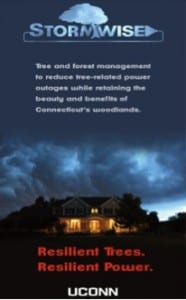 Two major storms that struck Connecticut and much of the northeastern U.S. in 2011 resulted in extended power outages and billions of dollars in property, and interior forest damage. As Connecticut seeks to lower future damage risk while sustaining the trees and forests that are so essential to our daily lives, management of infrastructure-adjacent forests has become a high-priority. Developing healthy, storm resistant forests requires adaptive stand management from the forest edge to the interior that preserves aesthetic appeal, biodiversity and other forest amenities. A new collaborative effort now underway at UConn will promote the positive potential of proactive “Stormwise” forest management to utility, municipal, landowner and public stakeholders.
Two major storms that struck Connecticut and much of the northeastern U.S. in 2011 resulted in extended power outages and billions of dollars in property, and interior forest damage. As Connecticut seeks to lower future damage risk while sustaining the trees and forests that are so essential to our daily lives, management of infrastructure-adjacent forests has become a high-priority. Developing healthy, storm resistant forests requires adaptive stand management from the forest edge to the interior that preserves aesthetic appeal, biodiversity and other forest amenities. A new collaborative effort now underway at UConn will promote the positive potential of proactive “Stormwise” forest management to utility, municipal, landowner and public stakeholders.
“Stormwise” is a multi-disciplinary concept initiated at UConn’s Department of Natural Resources and Environment to address the challenges associated with power-line and road corridors that traverse forested landscapes. The intent of the “Stormwise” vegetation management initiative is to demonstrate to and educate decision-makers and the public about management strategies to reduce the risk of tree-related power and transportation disruptions during storms. Applying scientific principles from tree growth and biomechanics, forest ecology and silviculture along with arboricultural and silvicultural techniques, we intend to show how desirable forest conditions (combinations of species mixes, age structures and densities) can be established and grown along power-line and road corridors that are wind-firm, healthy, aesthetically pleasing and address multiple environmental goals. In the process we also hope to stimulate local economic activity and work-force training, specifically in appropriate silvicultural and arboricultural skills and local forest product utilization.
The “Stormwise” effort is being sponsored by Northeast Utilities and United Illuminat-ing power utility companies, includes other strategic partners, and is part of a broader initiative that includes a predictive storm weather modeling project being conducted by the School of Engineering.
“Stormwise” is designed to promote healthy, storm resistant forests. The project will encourage local solutions in-volving homeowners, community leaders, planners, and others in an effort to protect people, power lines and prop-erty from tree-fall risk. We seek to create a highly unique and visible statewide “Stormwise” program embodying a positive message about forest resource stewardship and the value of healthy, storm-resistant trees and forests. Re-sults of recent and ongoing forest-edge/tree movement and crop-tree bio-dynamics research being conducted by Dr. Mark Rudnicki will be applied as innovative practices utilizing integrated arboricultural and silvicultural techniques. “Stormwise” treatment demonstration sites with healthier trees and increased storm resistance will be used as educa-tional focal points for a series of planned workshops. Sites will also be used to monitor, evaluate, and adjust man-agement protocols that integrate proactive arboricultural and silvicultural practices. Building on current outreach and research activities led by Associate Extension Professor Tom Worthley, the project will promote marketing strategies for harvested wood at appropriate scales to help align forest resource sustainability with community-level economic development and local entrepreneurial interests.
Lessons learned on integrating arboricultural and silvicultural practices to create “Stormwise” forests will be incor-porated into outreach materials and workshop presentations, elevating public interest in long-term forest steward-ship. This project will result in an immediate resistance to damage from severe storms, increased knowledge and capacity of natural resource managers, local production of value-added forest products and improved public appreciation of forestry.